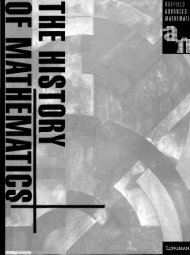Teachers' guide 2 - National STEM Centre
Teachers' guide 2 - National STEM Centre
Teachers' guide 2 - National STEM Centre
Create successful ePaper yourself
Turn your PDF publications into a flip-book with our unique Google optimized e-Paper software.
Models and other visual aIds<br />
Figure M.3<br />
An overhead projector in use. Projector by 3M Company<br />
To prepare transparencies from printed originals, methods such as a photographic<br />
diffusion process or a thermal process are available. The different types<br />
of transparency which can be prepared by the thermal process make it particularly<br />
suitable for the chemistry printed originals and the method is very simple.<br />
The infra-red copier machine is first warmed up by passing a plain sheet of<br />
paper through two or three times, the temperature control dial is then set to<br />
give an appropriate machine speed, and finally a sheet of specially coated acetate<br />
film is placed on top of the printed original and passed through the copier. The<br />
transparency is produced in a few seconds ready for use.<br />
The 3M Company manufacture a variety of coated acetate films. Type 133 is a<br />
thin but very strong sheet on which a black image is produced by the thermal<br />
process. It is suitable for most of the chemistry printed originals. Type 127 is a<br />
thicker sheet useful for transparencies which are likely to be written on (see<br />
below) or frequently handled. Ifan original contains fine detail, or if typewritten<br />
information has been added, Type 125 is more suitable as the thermal process<br />
produces a fine line frosted image. There is also Type 888 available as a . rainbow<br />
pack' from which transparencies can be prepared in five different colours. It is<br />
especially useful for the preparation of overlays (see below).<br />
293

















